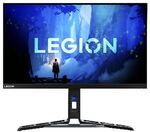Difficult to find many reviews on this monitor, only a couple of chinese youtube videos. But not aware of anything cheaper that is 27" QHD IPS 240hz. Anyone got this? Seems like a good choice for work + fps gaming?
Lenovo Legion 27" QHD IPS 240Hz Gaming Monitor Y27qf-30 $497 + Delivery ($0 to Metro/ in-Store Pickup) @ Officeworks
Last edited 19/11/2023 - 14:38 by 1 other user
Related Stores
closed Comments

Is there burn in issues with qd-oled?
Is the 240hz ips same tech as 165hz ips?
240Hz IPS tends to be a step forward from 165Hz, it's just not as dramatic as modern 240Hz TN or 240Hz VA in Samsung's latest G6 and G7 monitors. It's a stark visual difference.
QD-OLED will of course eventually have burn in issues, particularly if you're viewing a lot of white or bright coloured content - but WOLED is no different in this respect despite early reporting on the matter.
I've also left out that LG WOLED will aim for QHD 480Hz next year as well, which would stand above the 540Hz TN and 360Hz QD-OLED releases when it comes to motion clarity.

In a market where OLED prices are about to start dipping
Press X to doubt
Feel like people have been saying that for years

We just had a deal where the G9 240Hz OLED went for $1400, and the LG WOLEDs are about to go into fire sale mode.
TVs have already hit the $1000 mark at 42" and $1400 at 55"… it's happening.

I dunno, prices shuffling around at the 1 grand+ mark doesn't do much to move the needle for products in this price range

@jasswolf: Mm yeah I guess it's because I don't particularly care about high refresh rates like this. So I just see a plain IPS 1440p monitor still costing $500 lol, so it feels a bit stagnant to me. Good for competitive gamers or people with 4080s I guess

@Diji: Yup, straight QHD is tippling on $200, so we're in a good spot overall.
You should definitely check out the new 540Hz TN panel, it's remarkable in terms of being able to even read text at extremely high speed.

@Diji: I mean today it's esports titles, in the future you'll get a GPU upgrade. If you're making an 7-8 year investment in a monitor that's a consideration.
I know game devs still try to target 60 FPS for cinematic style stuff, but the truth is VR is going to make its presence felt and will help push high frame rate content as all panels drive for 1000+ Hz.

@jasswolf: Headroom is nice but I rarely go back and play older games except for some classics like my annual JA2 ritual. I can definitely see the benefit of high refresh rates but it's just not something that drives my purchasing decision. If it was like, this monitor is a bargain and it happens to have a high refresh rate as well as ticking my other boxes, then sure. But most other factors come before refresh rate, like I'd rather a lower refresh with good local dimming, because I can see PC HDR getting good well before developers target high refresh rates since they still don't even target 120 Hz!

@Diji: Developers are already targeting 120 FPS through frame generation, and that's likely going to double to 240 FPS with next gen GPUs… and that's just the baseline.

@Diji: I'm specifically referring to how developers are utilising DLSS frame generation at this stage, but eventually such technology will be baked in as a universal standard via DirectML.

@Diji: 50 series will be doing upwards of 4K 240FPS with pathtracing using this tech in the top end, it's well and truly mainstream now… comparatively AMD's hardware capability sits somewhere between the GTX 16 series and the RTX 20 series but with more shaders.
5 years is probably stretching it. :P


Here's a technical review (Chinese with subtitles).
Seems about the same as early QHD 240Hz IPS, which struggles alongside VA and OLED counterparts for motion clarity.
QHD 360Hz IPS (2nd gen 360Hz IPS tech) does a much better job, but still falls a fair way behind what TN (540Hz) and OLED (360Hz) are doing for motion clarity, while OLED offers better colour accuracy, HDR fidelity, and viewing angles, with 2nd gen QD-OLED being class leading in colour volume.
In a market where OLED prices are about to start dipping through maufacturing ramp, this kind of monitor should be $400-$450 soon enough.